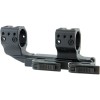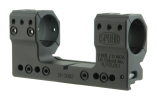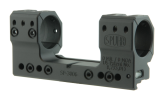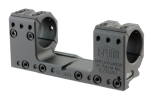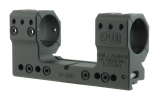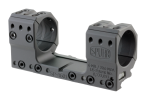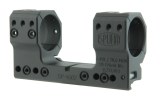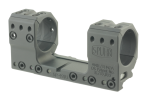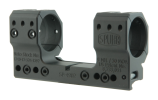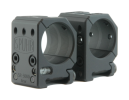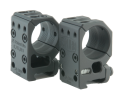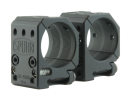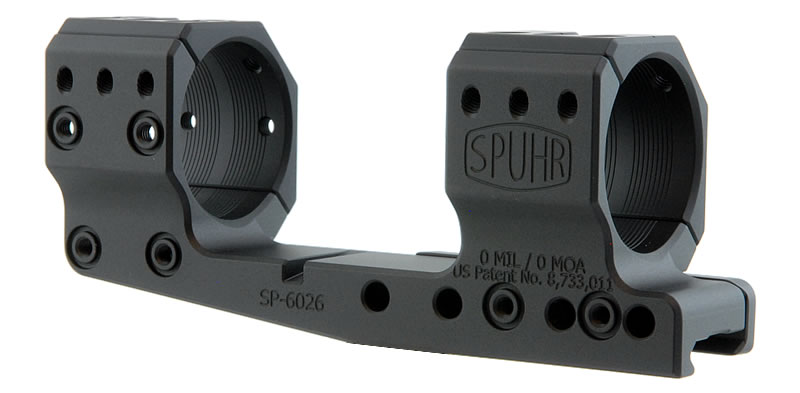
Picatinny or direct mount?
The first obvious question is if the mount should be a Picatinny mount (models beginning with SP or QDP) or a direct attachment mount such as our line of ISMS mounts for Accuracy International (SA,) Sako TRG/Tikka T3 (ST,) and Sauer STR (SS.)
The main reason for using a direct mount is to allow a stronger and lower positioning of the rifle scope. If there’s no other need for a Picatinny rail, we generally recommend direct mounts on these rifles.
Height
The height of our mounts is always measured from the top of the Picatinny rail (or the receiver for direct mounts) to the center of the scope. In the case of a tilted mount the measurement is made at the back plane of the rear ring.
So which height do you need? First off you need to know the outer diameter of your objective. Please note that "3-12x56" does not mean that the scope has an outer objective diameter of 56 mm - only that the objective lens is 56 mm in diameter. Different scopes have different outer diameters for the same lens diameters and it's not uncommon that different models from the same manufacturer feature different outer diameters even if the lens diameter is the same.
Take the measurement above and divide it by two (2) to get the theoretical minimum height required if the optics will be mounted onto a flat rail that extends to and/or past the objective bell. This theoretical minimum height is theoretical for a reason. If the objective has a 62 mm outer diameter and you choose a 31 mm high mount the objective will be in contact with the rail. You will therefore need to add to the theoretical minimum height to get the practical minimum height.
So how much do you need to add? That depends on your personal preference and on what kind of lens caps etc.., you want to use. Also, if you want to use a tilted mount/base you will need to add additional clearance.
If you intend to mount the optics onto a bolt action rifle with Picatinny scope base you can often use a lower mount than the theoretical minimum height above. Just subtract the height of the scope base from the theoretical minimum height mentioned above. Depending on barrel contour you might be able to go even lower. But don't forget to leave some clearance for lens caps and/or sunshades!
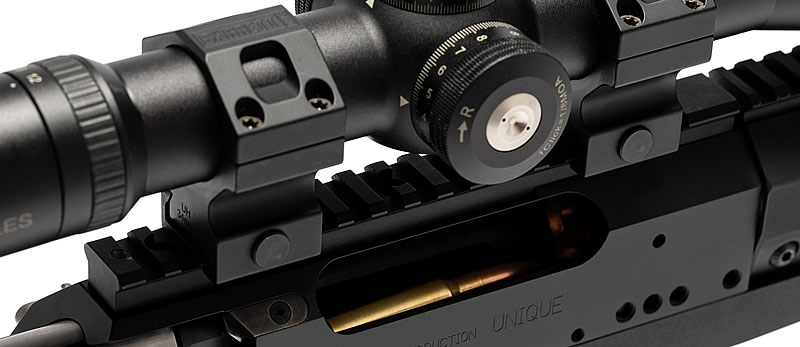
Tilt
Tilted mounts are necessary when shooting at very long distances. We generally recommend as little tilt as possible as large amounts of tilt really may have a negative impact on the quality of the sight picture. In most cases 6-9 MIL (20-30 MOA) will have no negative impact on picture quality while still providing greater available adjustment range for long-range shooting.
To allow for the greatest available range of adjustment choose a mount with a tilt that is half of the scope’s range of elevation. For example, Schmidt & Bender 5-25x56 have a maximum elevation adjustment of 26 MIL (93 MOA,) you should therefore choose a mount with 13 MIL (45 MOA) in tilt. Doing so assures that you are able to adjust the sight out to very long distances.
However, when mounted in this extreme elevation it’s common to experience optical defects such as a oval pictures when shooting at near targets, etc. We therefore recommend that when fitting a large elevation scope (such as 26 MIL/93 MOA) on a .308 rifle that will only be used out to 1000 meters, to choose a 6 MIL/20 MOA tilt as it’s more than sufficient for that use.
Please note that using a degree of tilt that is more than half of the scope's elevation adjustment will make it impossible to zero your rifle at 100!
Night vision / thermal compatibility
When combining the scope with a clip-on system such as PVS22 or NSV 80, to name a few, the height of the mount is not important. Also, the instrument doesn’t have to be perfectly in line with the scope.
If we have an offset of 10 mm in height between the primary optic and the NV clip-on the change in point of impact will be 10 mm on 100 meters as well as 10 mm on 300 and 1000 meters; thus, the point of impact change is fully parallel.
Therefore, it’s often unnecessary to have extremely high mounts just to facilitate in-line mounting of a clip-on system. Various systems allow varying degrees of angular difference. A common maximum angular difference is 2 degrees. If you do want a perfect alignment, we do offer the A-700 Clip-On Adapter that will fit onto any of our SP-***1 and SP-***2 mounts.
Please consult the manufacturer of the thermal device before you make expensive alterations to your gear.

 Turkey: The Phenomenon of Counterfeit Hunting and Shooting Firearms
Turkey: The Phenomenon of Counterfeit Hunting and Shooting Firearms
 The Art of Firearm Maintenance: Beyond Routine, A Renewed Passion with RifleCX
The Art of Firearm Maintenance: Beyond Routine, A Renewed Passion with RifleCX
 The Gun Behind the Legend- The KING ELEVEN 1911 Pistol
The Gun Behind the Legend- The KING ELEVEN 1911 Pistol
 The Duel of Popular Calibers: The History of .30-06 and .308 Win
The Duel of Popular Calibers: The History of .30-06 and .308 Win
 The Superiority of .308 Win Caliber in Hunting: An In-Depth Analysis
The Superiority of .308 Win Caliber in Hunting: An In-Depth Analysis
